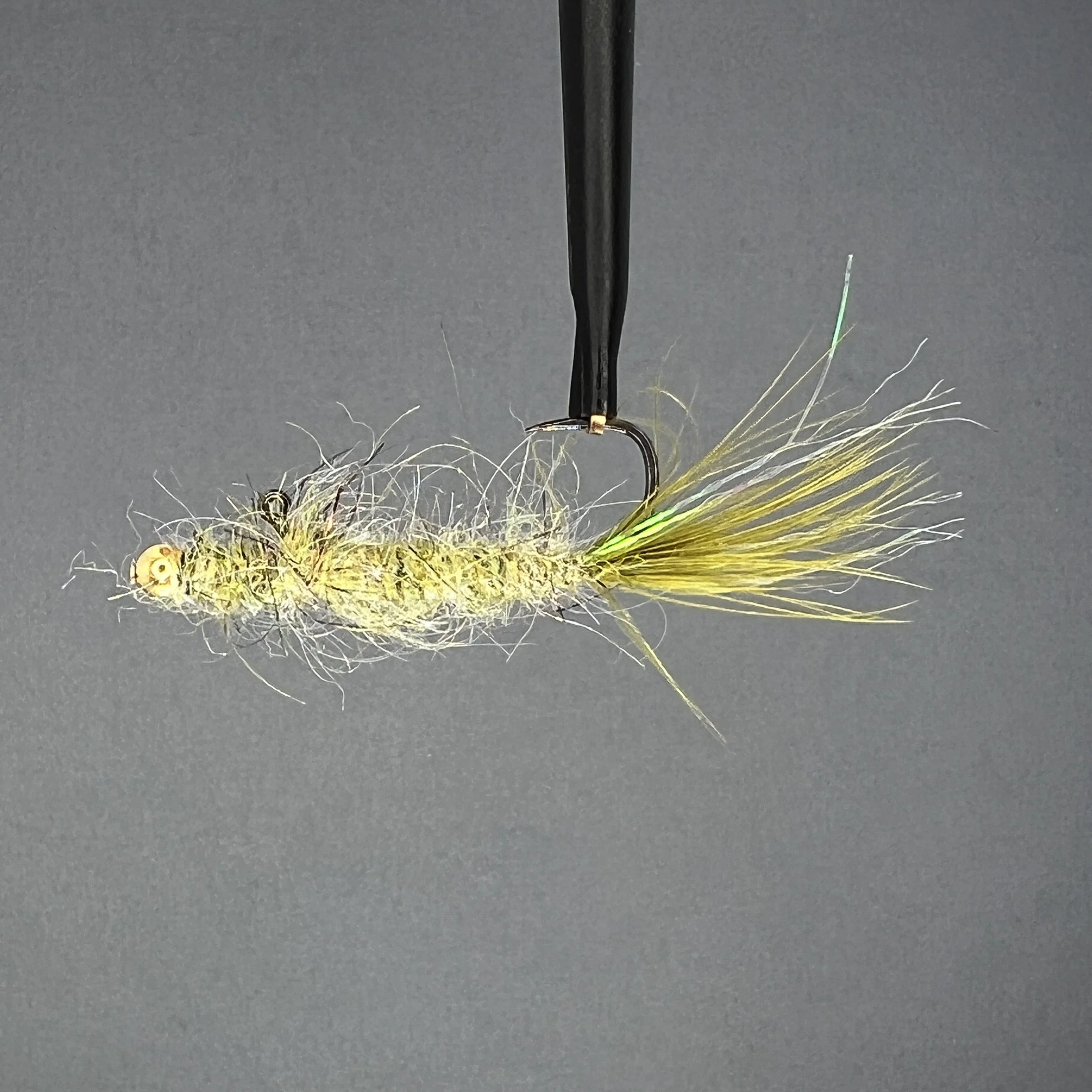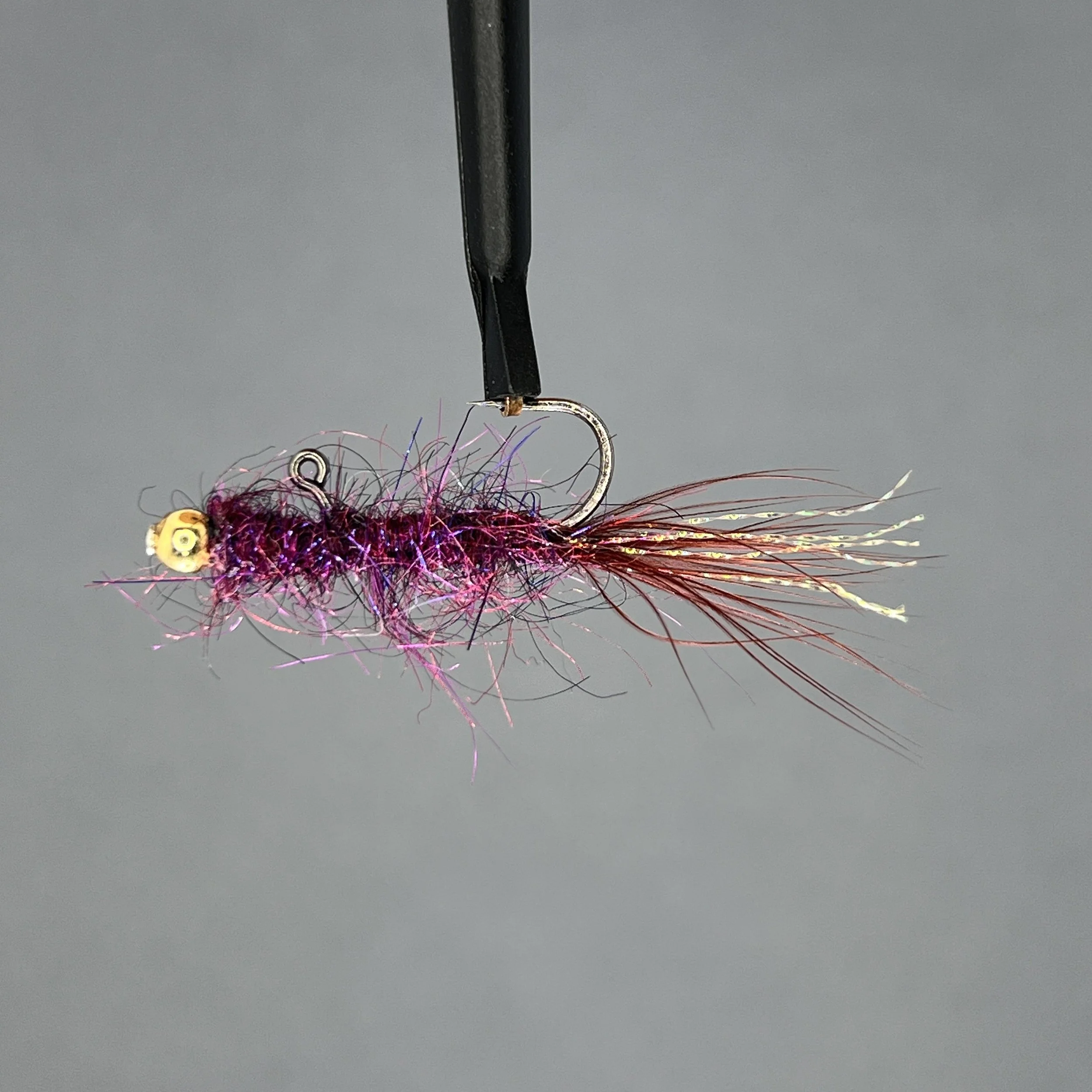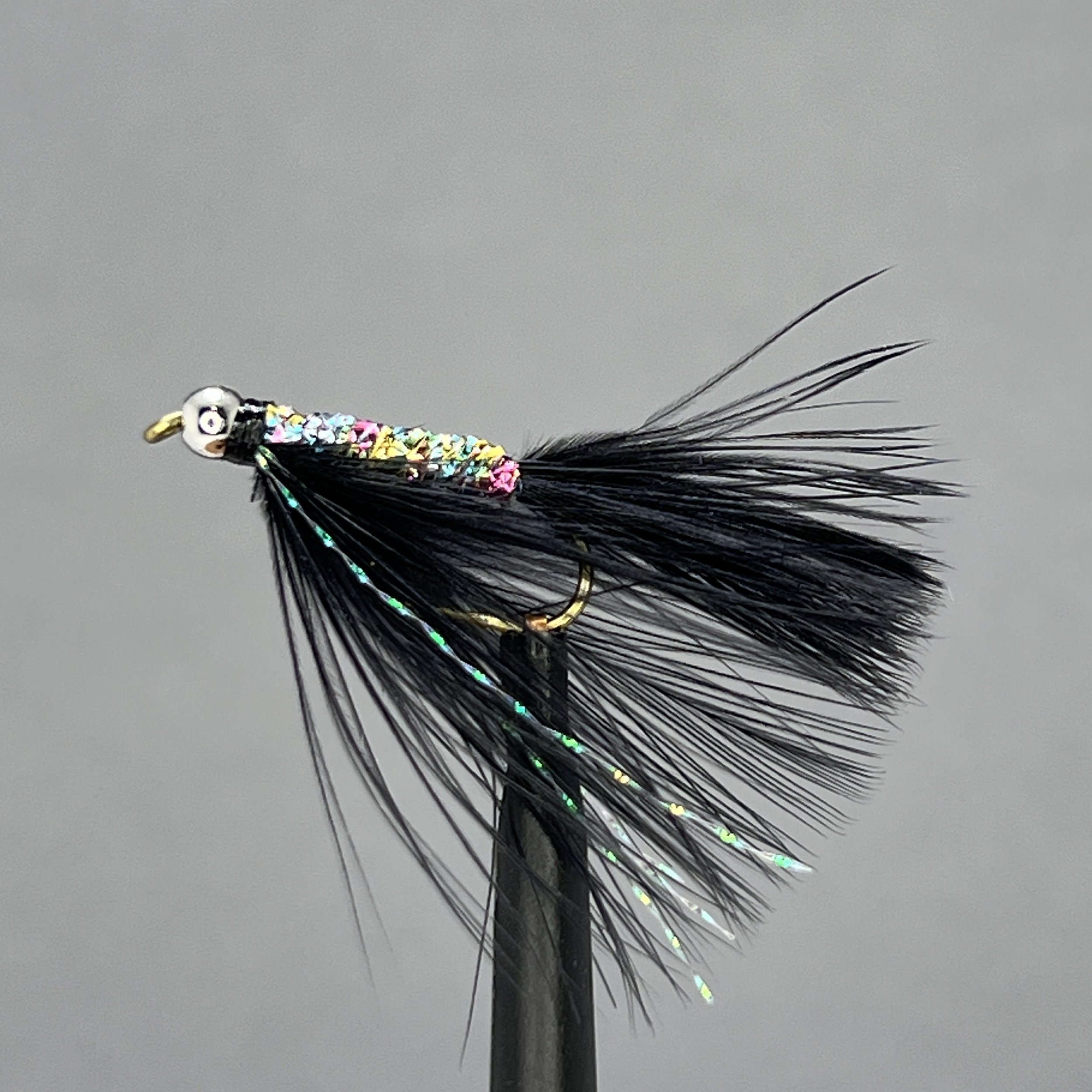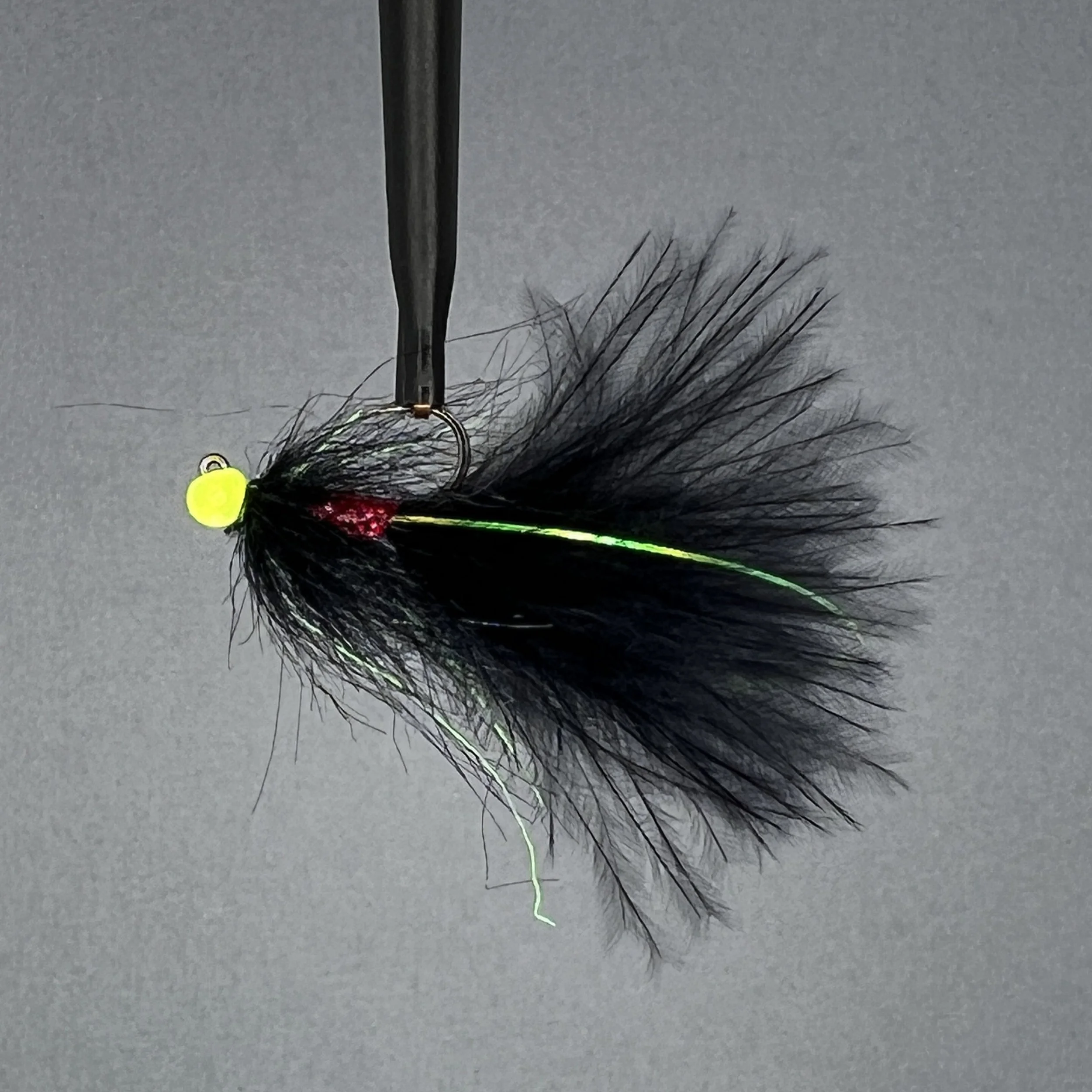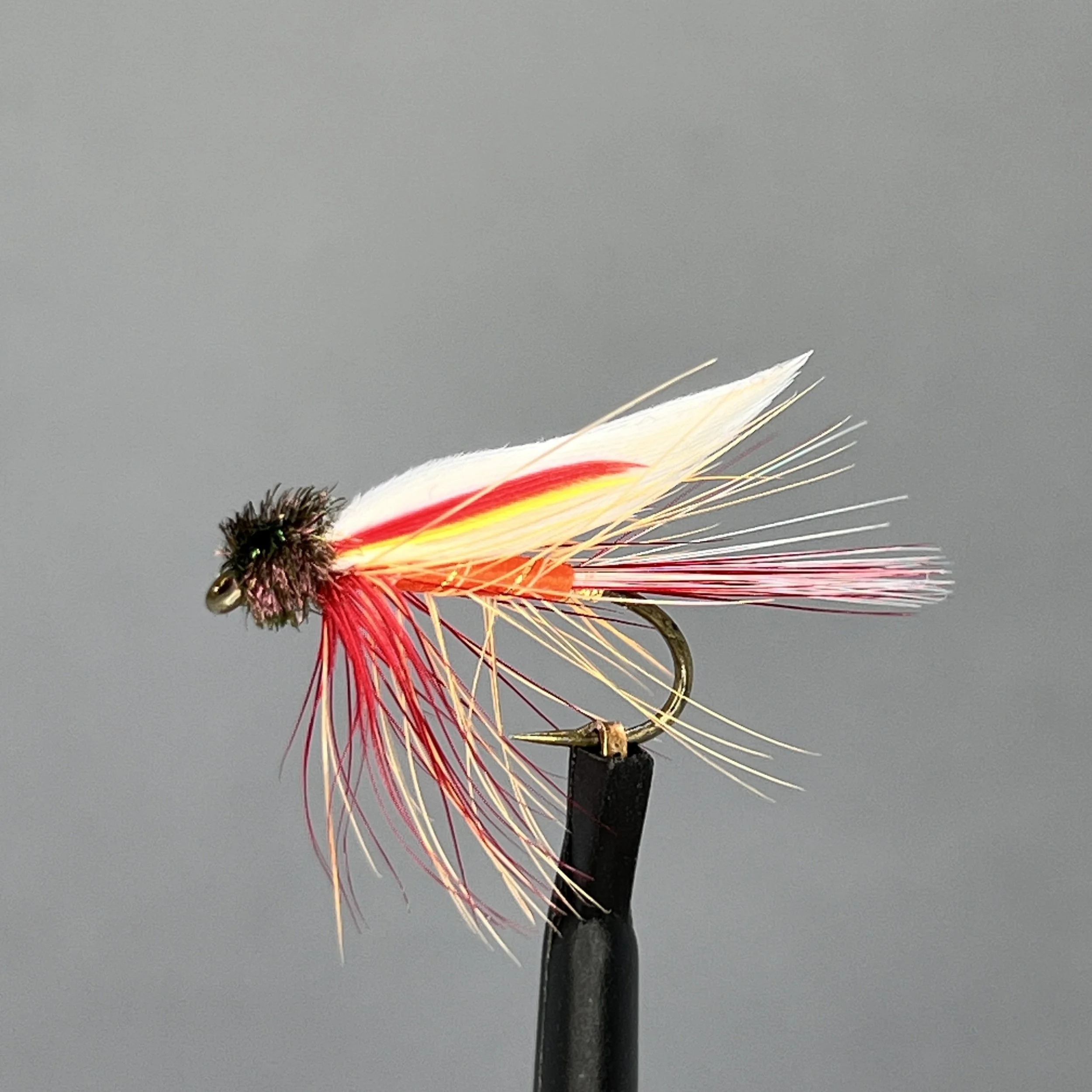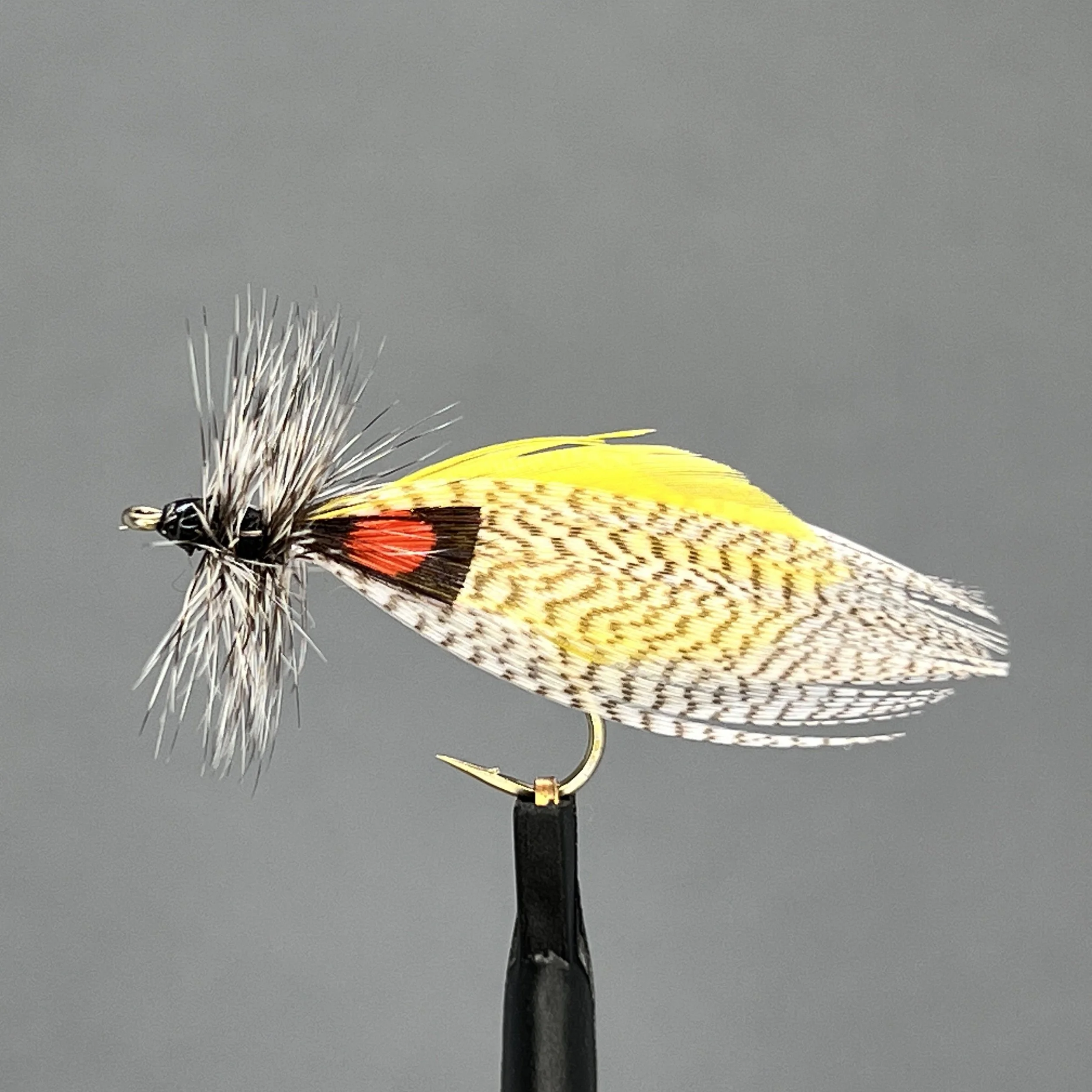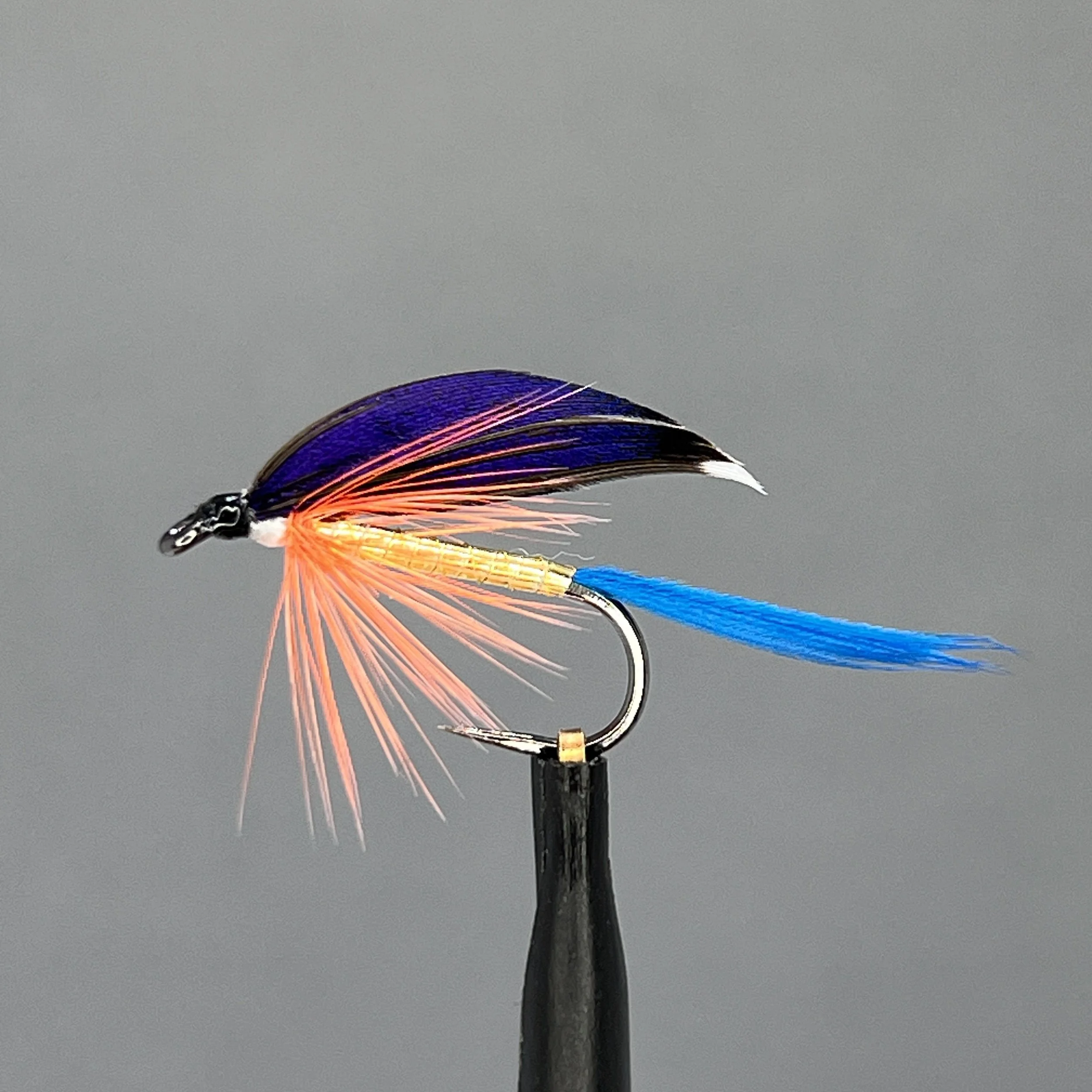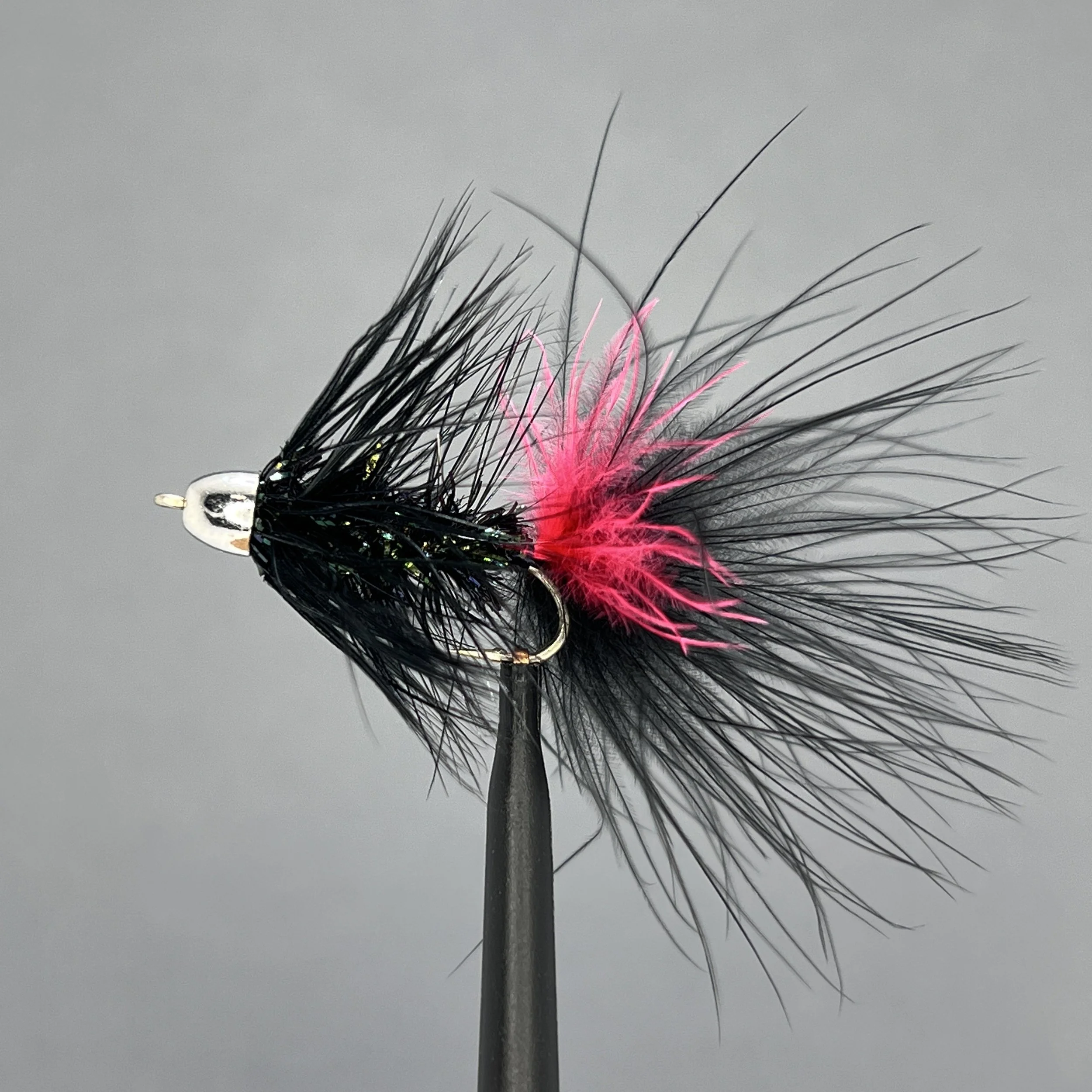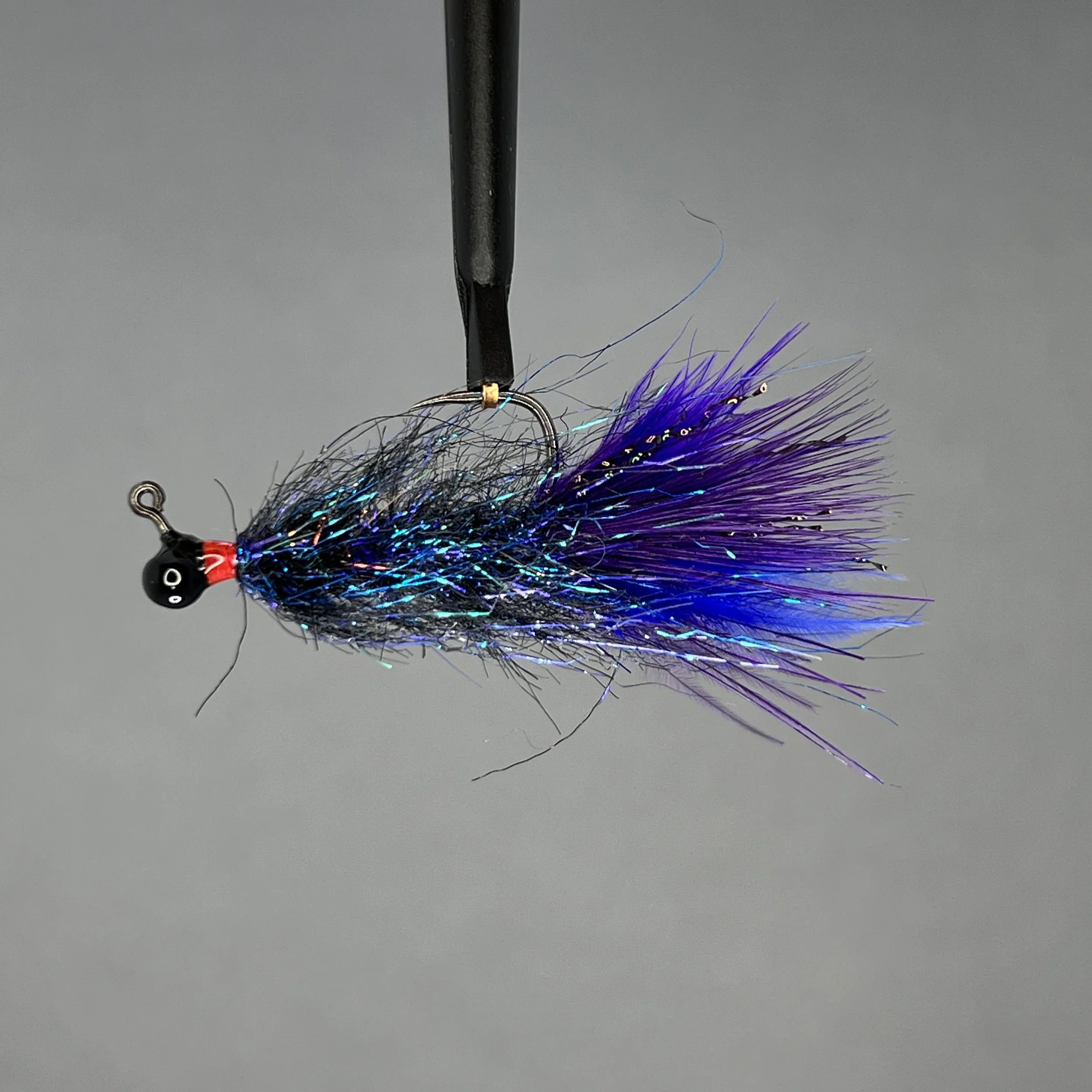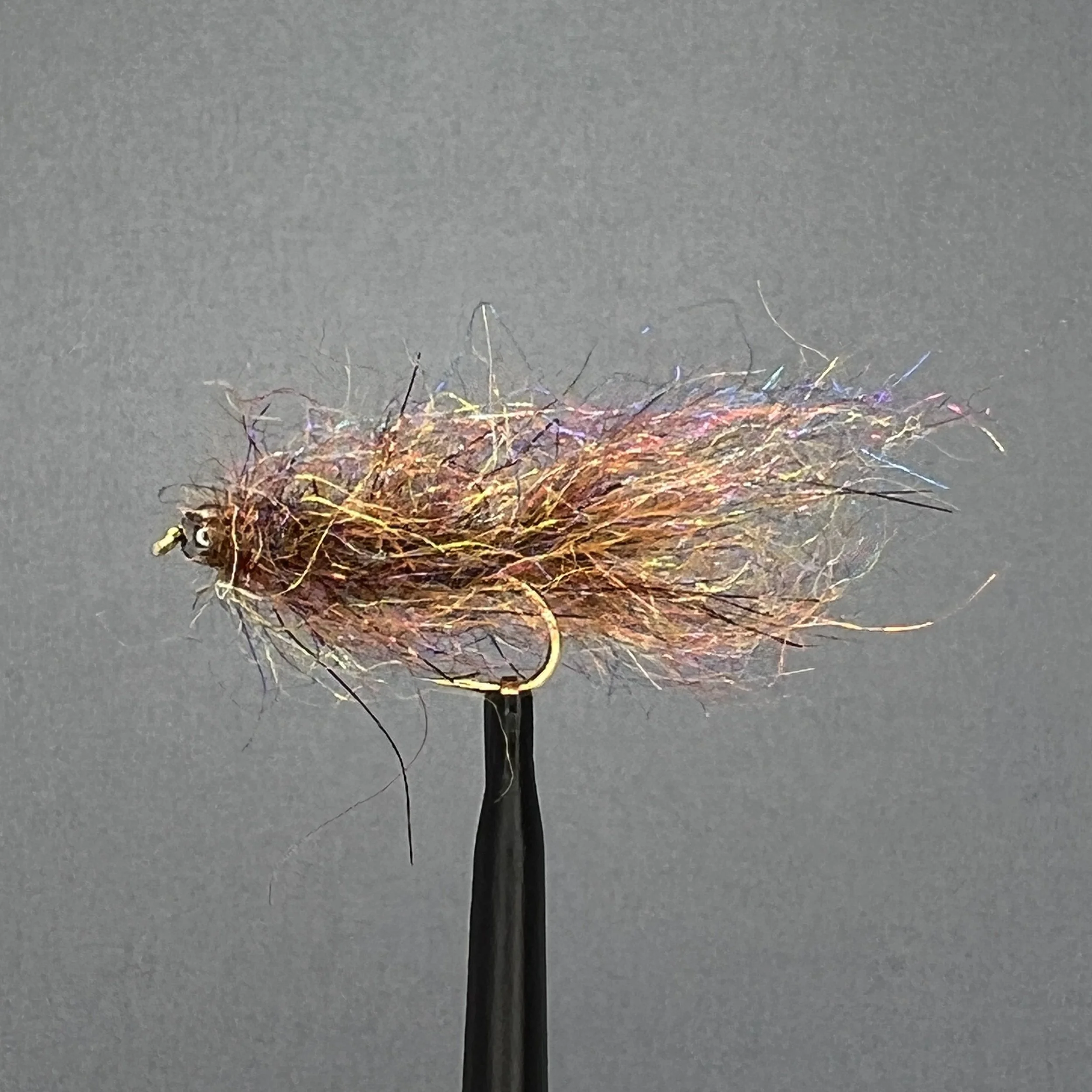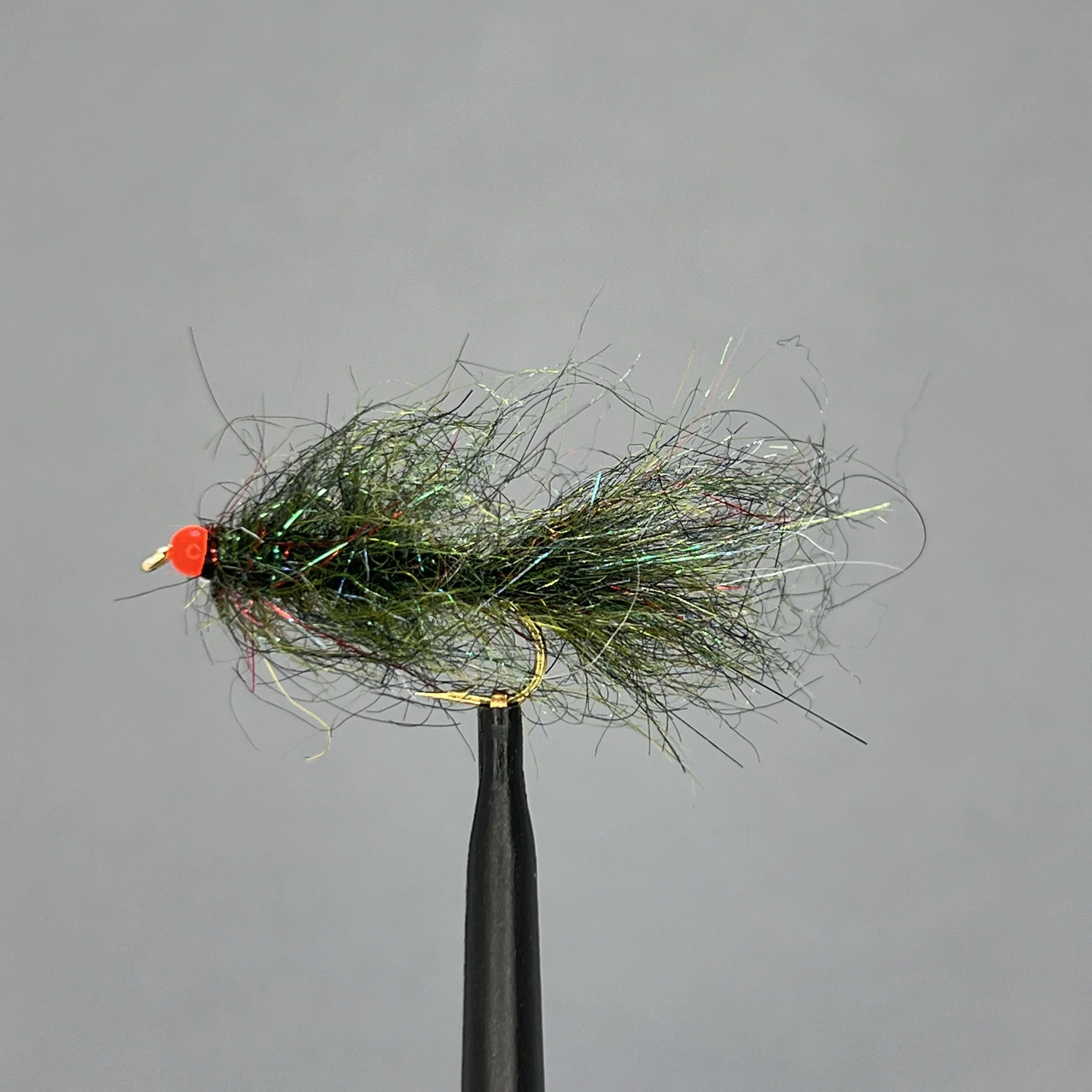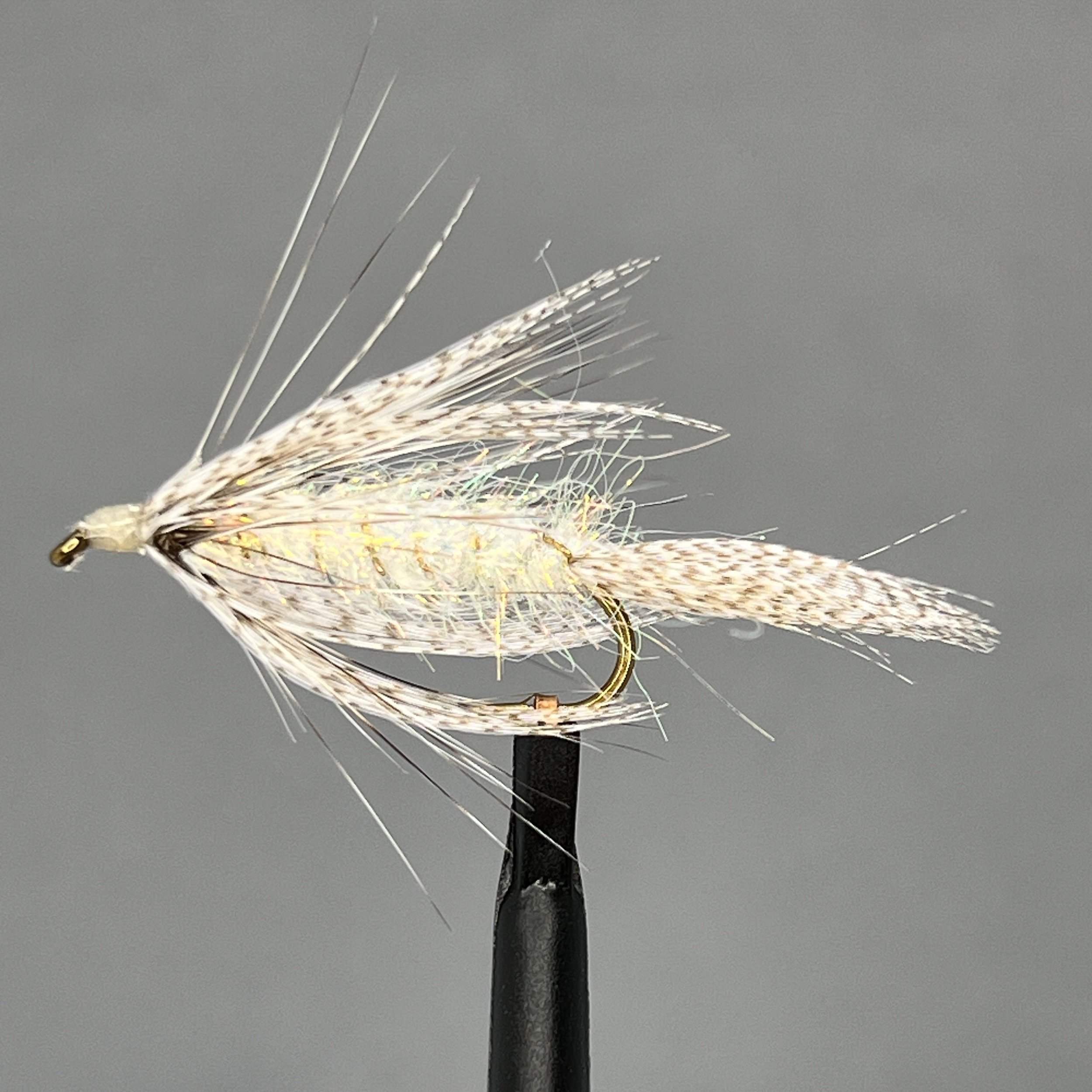Streamers and Attractors
Doug Anderson
Balanced Leech
#6 to 12, standard jig hook, 2 or 3X length
Hook:
Marabou color to match body, 1/2 to full length of body
Tail:
Size 6 or 8; color to match body
Thread:
Arizona simiseal in a dubbing loop. Olive, tan, browns, black, purple all work. Well brushed out on finished fly.
Body:
Tungsten bead on straight pin
Head:
Notes: First step is to tie a straight pin (with bead) onto the hook adding 1/4 to 1/2 additional body length (depending on weight of bead). If your straight pin is too long for the hook just cut it to the proper length with a good wire cutter.
Fish with a slow retrieve stopping frequently. Has been very effective in lakes for all species of trout and small mouth bass (in warmer water). Killer pattern for lakes in the White Mountains of Arizona once you find the size and color they want that day (or hour). I didn't know about this fly the 18 years I was fishing in Washington and Oregon.
Black Rufus
Marv Yoshinaka
#10 Tiemco 5263 (larger or smaller sizes as needed)
Hook:
Black, 8/0 or 6/0 Uni-thread
Thread:
Rainbow Diamond Braid. Can also use flashy chenille for the body. Use other colors for the body such as silver, gold, olive or red when using other colors of marabou
Body:
Black Marabou
Tail:
Black marabou with a few strands of Krystal Flash. This fly has a wing/beard that extends from the head of the fly to the end of the tail.
Wing/ Beard:
Black thread, 1/8" or 5/32" tungsten nickel bead. You can also use other colors of beads.
Head:
Notes: This fly was developed by Bob Gaviglio who owned the Sunriver Fly Shop. He also has tied the fly in other colors for the wing and tail including olive, brown, red, and burnt orange. I have also used yellow marabou for this fly pattern. Each of the colors will work well under certain conditions so change colors until you find one that the fish prefer It is a great attractor fly and has caught fish in all stillwaters that I have fished. I generally fish this fly by casting it, letting it sink and retrieving it with short jerks. This fly, tied in a larger size, can also be effective for steelhead.
Coldwater Lake Leech
Paul Dunlap
#10 Hanák 400 Bl jig hook
Hook:
Black Semperfli Nano Silk 12/0
Thread:
Black marabou with chartreuse Flashabou
Tail:
Red Lagartun French Flatbraid and Spawn UV Simi Seal Dubbing Black/UV Chartreuse Green
Body:
Black marabou with chartreuse Flashabou
Tail:
1/8-3.3 Togens Tungsten Jigoff Cool Bead in Fluro Chartreuse
Head:
Notes: A larger bead can be used for a faster sink rate if needed.
Conway Special
Greg Clarke
#10 wet fly
Hook:
White nano silk
Thread:
Mixed crimson red and white hackle barbs
Tail:
Orange silk floss with orange hackle( palmered)
Body:
Fine oval gold tinsel
Rib:
White goose shoulder with thin married red plus yellow goose over
Wing:
Crimson red hackle collar
Hackle:
Fine oval gold tinsel
Tag:
Peacock herl
Head:
Notes: Designed by Dan Conway. Good for brookies in lakes.
Hornberg
Jack Glode
#8 Daiichi 1260
Hook:
Black Veevus size 6
Thread:
Silver holographic tinsel
Body:
Inner wing: yellow saddle. Outer wing: Mallard flank or Wood Duck natural
Wing:
Grizzly
Hackel:
Jungle cock no longer available. Used large Guinea eyes.
Eyes:
Cement
Head:
Notes: Designed by Frank Hornberg in 1920”s.
Frequently tied on smaller hooks as attractor pattern.
Popular fly 1950’s in my home town Saratoga WY. Used in lakes and streams. Usually fished as streamer, sometimes weighted. Smaller size can be used as attractor, then swung as streamer.
Kingfisher Butcher
Greg Clarke
#10 wet fly
Hook:
White nano silk
Thread:
Kingfisher blue goose shoulder
Tail:
White unistretch underbody; flat gold tinsel
Body:
Fine gold wire
Rib:
Mallard speculum
Wing:
Orange hackle
Hackle:
Black thread
Head:
Notes: Very good lake fly designed by James Ogden (?)
Kris Kringle
Jack Whitney
Wolly Bugger hook
Hook:
Light Green
Thread:
A small pinch of red dubbing
Tail:
Light green dubbing
Body:
Green barbed, palmered along body. Barb dark green saddle hackle
Hackel:
Pearl bead
Head:
Notes: Ed Sale came up with this fly and tied a handful of them which he passed out telling us what a great fly it was. Great for Eastern Washington lakes. So I took a couple and fished them. I caught a few fish, so I kept it in my fly box. Before the poachers discovered Lake Lenore and greatly depleted the population, CSF fished it frequently. The poaching removed a lot of fish and the fishing went sour. So we went on to other lakes which held fish, but not as big and plentiful as the Lahontan Cutthroat in Lake Lenore had been. After several years, we heard that Lake Lenore was again fishing well, so we decided to try it on our way back to Soap Lake from the lakes we had been fishing that day. About a dozen of us stopped for an hour of fishing. I chose to fish the Kris Kringle. During that hour, one person didn’t have any luck and the balance caught one, except for myself and another member who caught two fish each. Usually I am the one who is fishless, so it had to be the fly I was using—the Kris Kringle. When I next saw Ed and told him of my success, he looked me directly in the eye and started to laugh, saying that fly was tied as a joke and not meant to be fished.
Timothy Buckley
Little Fort Leech
#6-10 (2XL or streamer hook), barbless
Hook:
Black to suit
Thread:
Black chenille, or dark peacock chenille
Body:
Black Marabou (with a shorter “hot spot” pinch of red marabou on top)
Tail:
Black saddle, palmered skinny from the back to larger in front.
Hackle:
Bead or cone to suit
Head:
Notes:
How To Fish it: I generally use this fly as a searching pattern on a sinking or intermediate line, and will often throw one on and troll with it while rowing to a different part of the lake… Just make certain to have your rod well secured as some of the strikes have been very violent (two of my friends nearly lost rods).
My Notebook: This is another fly I learned about preparing for a fly fishing trip to the plateau alpine lakes north of Kamloops and north west of Little Fort, British Columbia. It was the recommended go-to fly by the fishing camp owner I was heading to. I purchased a handful at the Little Fort Fly Shop along with my license on my way into the wilderness to get to the fishing camp, and quickly discovered why it is recommended by the locals. Day one I had lost half of the flies on huge strikes before amping up my tippet. Fortunately I had brought my tying kit, and with these simple materials kept myself in stock by tying in the cabin at night. It is still a favorite searching pattern I use regularly in Washington lakes, often to great success. This includes a trip this season back to the Kamloops area in BC where I brought to hand my largest trout in 10 years.
Red Neck Balanced Leech
Ed Sale
#10 Fulling Mill Jig Force, long black nickel
Hook:
Black 6-0; Neck - Ultra Thread Fl. Red
Thread:
Dark purple maribou, black Crystal Flash
Tail:
Arizona Diamond Black Blue Dubbing
Body:
Hareline Insta Jig Tungsten head.
Head:
Notes: After tying body, add Fl Red 140 denier thread "neck". Suggest super glue Tungsten Head before tying rest of fly. When done dip fly in almost boiling water to make dubbing stream back smoothly.
Generally fished under an indicator about 6-9 feet. Found it very effective in lakes such as Coldwater, Burke, Oregon Fishing Club lakes, Laurence Lake, and Timothy Lake
Steve Jones
Reverse Spider
#6-10 Daiichi 1270 or TMC 3761
Hook:
Ultra 140 Denier color to match dubbing
Thread
Mallard
Tail:
Yellow, black, tan, pink, white, orange, etc. dubbing palmered with Grizzly hackel or your choice but not necessary
Body:
Mallard flank
Hackle:
Plastic beads to compliment dubbing if you choose, or brass beads.
Head:
Notes: Use the tip of the Mallard flank for the tail. You tie this fly backwards. Tie in the hackle first and tie it so the curve of the feather arcs forward over the eye of the hook. Then move the thread to the back to tie in the tail. Then add the dubbing. Tie off the thread right behind the front hackle.
This fly is ideal for searun cutthroat at or above tidewater on the Northwest Oregon coast and Hood Canal. Fish the fly on a floating line or with a poly or braided leader to sink it below the surface film. The reverse hackle creates a jerking motion amid a cloud of bubbles as your retrieve the fly, which drives cutthroat wild. Fish it on 6# Maxima ultra green or similar. Forget the 4x, this fly makes cuts mad.
Shawn West
Semiseal Leech
#8 3xl nymph
Hook:
Thread to match dubbing
Thread:
Arizona Simiseal
Tail:
Arizona Semiseal. Shown in Watermelon Red
Body:
Brass or tungsten bead; plain or colored
Head:
Notes: Tie fairly sparse.
These are very effective for small mouth bass in the Columbia River and its embayments. My favorite colors are watermelon red, black and red, and black and blue.
Kuni Masuda
Shakey Bealy
#8 to 16 Tiemco 5262 2X nymph
Hook:
8/0 or 70 Denier, rusty brown
Thread:
Woodduck or dyed Mallard flank feather
Tail:
Light olive dubbing
Body:
Natural partridge feather and orange Crystal Flash
Hackel:
3/0 or 210 denier thread, rusty brown
Rib:
Brown thread
Head:
Notes: This attractor pattern was developed by Frank Beals. It represents emerging caddis flies as they ascended to the surface. Also, more colorful versions could simulate small baitfish. Very simple fly for beginning tiers. This attractor wet fly, swinging along on a sinking line, grabs the attention of browns and rainbows.
Mike Butcher
White Ghost
#6 to #10 Daiichi 1720; 2x or 3X long nymph hook
Hook:
Thread
White, 8/0
Mallard flank
Tail:
Ice Dub, Pearl Red or STS Tri Lobal, white. Brush out to your preference.
Body:
Medium gold tinsel
Rib:
Under hackle I use two turns or so over grizzly neck fiber. Over hackle, one to two turns of mallard flank in spider fashion. The grizzly keeps the mallard from sticking close to the body.
Hackle:
White thread. However, when using as a baitfish imitation, I've been playing with silver and blue tungsten beads.
Head:
Notes: I'm drawn to the old patterns I was introduced to as a kid. I've known about the White Ghost almost as long as I can remember being alive. The White Ghost is an old Southwest Washington “Harvest trout” pattern, Harvest trout being the nom de rigueur for sea-run cutthroat trout in Southwest Washington.
All of my mentors that have passed were fond of the White Ghost. Watching a March summer steelhead take the "Ghost" on the lower Toutle River was awe inspiring. Both for the take of the fly itself and the rarity of summer runs in the Toutle at that time. Although the "Ghost" was designed for Harvest trout, it makes a great baitfish pattern, especially in salt water. A buddy used it with great success on Bristol Bay streams for ice out Bows with added strips of blue flashabou.
© 2025 Clark-Skamania Flyfishers PO Box 644 Vancouver, Washington 98666 info@csfly.net

